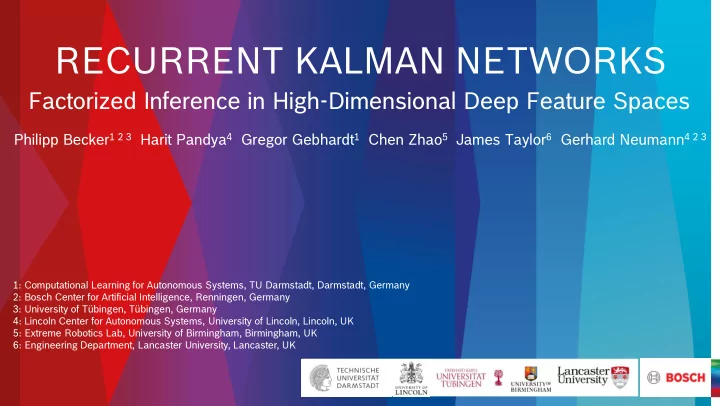

RECURRENT KALMAN NETWORKS Factorized Inference in High-Dimensional Deep Feature Spaces Philipp Becker 1 2 3 Harit Pandya 4 Gregor Gebhardt 1 Chen Zhao 5 James Taylor 6 Gerhard Neumann 4 2 3 1: Computational Learning for Autonomous Systems, TU Darmstadt, Darmstadt, Germany 2: Bosch Center for Artificial Intelligence, Renningen, Germany 3: University of Tübingen, Tübingen, Germany 4: Lincoln Center for Autonomous Systems, University of Lincoln, Lincoln, UK 5: Extreme Robotics Lab, University of Birmingham, Birmingham, UK 6: Engineering Department, Lancaster University, Lancaster, UK
Motivation Goal : State estimation from high dimensional observations Filtering Prediction states time 2 Philipp Becker | 2019-06-11
Motivation Goal : State estimation from high dimensional observations Filtering Prediction Challenges: states High dimensional observations Partially observable time Nonlinear dynamics Uncertainty 2 Philipp Becker | 2019-06-11
Motivation Goal : State estimation from high dimensional observations Filtering Prediction Challenges: (Deep Learning) Solutions: states High dimensional observations CNNs Partially observable RNNs time Nonlinear dynamics Uncertainty x Variational Inference (approximation errors) 2 Philipp Becker | 2019-06-11
Motivation Goal : State estimation from high dimensional observations Filtering Prediction Challenges: (Deep Learning) Solutions: states High dimensional observations CNNs Partially observable RNNs time Nonlinear dynamics Uncertainty x Variational Inference (approximation errors) How can we propagate uncertainty through RNNs without approximations? Recurrent Kalman Networks (RKN): Recurrent cell based on Kalman filter 2 Philipp Becker | 2019-06-11
Overview Latent Observation + Uncertainty Latent State + Uncertainty Output + Observation Uncertainty 3 Philipp Becker | 2019-06-11
Overview Latent Observation + Uncertainty Latent State + Uncertainty Output + Observation Uncertainty Make backpropagation through Kalman filter feasible? Locally linear transition models, even for highly nonlinear systems High dimensional latent spaces Factorized state representation to avoid expensive and unstable matrix inversions 3 Philipp Becker | 2019-06-11
Factorized State Representation Observation Model Splits latent state 1. Observable part 2. Memory part 4 Philipp Becker | 2019-06-11
Factorized State Representation Observation Model Factorized Representation Splits latent state 1. Observable part diagonal matrices 2. Memory part correlates parts 4 Philipp Becker | 2019-06-11
Factorized State Representation Observation Model Factorized Representation Splits latent state 1. Observable part diagonal matrices 2. Memory part correlates parts Results in simplified Kalman Update No matrix inversion Makes inference and back-propagation feasible Instead only pointwise operations Assumptions not restrictive since latent space is learned 4 Philipp Becker | 2019-06-11
Quad Link Pendulum System: State (4 joint angles + velocity) Highly nonlinear dynamics Links occlude each other Estimate joint angles of all 4 links Inputs over time Observations: 48x48 pixel images 5 Philipp Becker | 2019-06-11
Quad Link Pendulum System: State (4 joint angles + velocity) Highly nonlinear dynamics Links occlude each other Estimate joint angles of all 4 links Inputs over time Observations: 48x48 pixel images RKN LSTM GRU Log 14.534 11.960 10.346 Likelihood RMSE 0.103 0.118 0.121 Significantly better uncertainty estimate (higher log-likelihood) Better prediction (smaller RMSE) 5 Philipp Becker | 2019-06-11
Summary & Conclusion Recurrent Kalman Networks… Additional Experiments Pendulum … scale to real world systems Image Imputation … allow direct state estimation from KITTI-Dataset for visual odometry images … use uncertainty in a principled manner to handle noise Prediction for real pneumatic joint … can be trained end-to-end without approximations Comparison to recent approaches KVAE [1], E2C [2], Structured Inference Networks [3] Code available [1]: Fraccaro et al. A disentangled recognition and nonlinear dynamics model for unsupervised learning. NIPS 2017 6 Philipp Becker | 2019-06-11 [2]: Watter et al. Embed to control: A locally linear latent dynamics model for control from raw images. NIPS, 2015 [3]: Krishnan et al. Structured inference networks for nonlinear state space models. AAAI, 2017
Recommend
More recommend